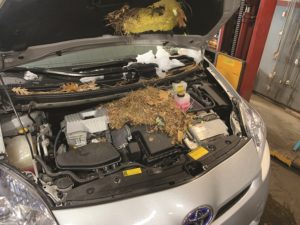When was the last time you checked under the hood?
More and more of my customers don’t even know how to open theirs. That’s not just because they’re not mechanically inclined. It’s also because cars don’t need oil changes as often as they used to. And radiators don’t need filling. So, you can be lulled into thinking there’s nothing under there that needs attention.
That would be wrong.
A couple of weeks ago, a customer brought in a Prius for servicing, and along with it came an entire family of mice. They had built a home for themselves, a McMansion, actually, using pine needles and leaves and insulation taken from the hood and, probably, from the house where the car is normally parked. It was the biggest nest I’ve ever seen.

Mice and squirrels — the red ones can be especially aggressive — regularly set up housekeeping on car engines when the weather turns cold. They’ll tear up your air filters, gnaw on belts, and do some real damage by chewing up your wiring (my informal research shows they especially like the soy-based wire insulation used by Toyota, Subaru, and Honda).
If a nest is located in an unfortunate spot like a fan or intake manifold, it can ignite. But I’ve actually heard of very few roasted rodents. They seem to know how to settle in for the long haul. In this case, for example, the car carrying that giant nest around actually gets driven daily.
I know people who have tried mothballs, dryer sheets, and rat repellent. None of it seems to do much to deter the rodents. You could honk your horn a couple of times every morning. People say that will annoy the mice. I know it will annoy your neighbors, though, so that’s not a solution for most of us.
By now, I hope you’re committed to having a look under the hood every time you stop to fill up for gas. If you don’t know how to open your hood, ask me or somebody at the gas station to show you. I promise you, it’ll be empowering.
Once you’re in there, besides checking for the beginnings of any nest that might be under construction by uninvited animals, there are a few other things you should do.
Check your oil. Cars are sold now with the promise of very long service intervals. I suspect that’s partly because the manufacturers’ marketing departments want to show the lowest possible cost of ownership for a car. But oil chemistry and engine technologies have evolved. You might not need a conventional oil change for 5,000 miles. Or, if your car uses synthetic oil, you might go 10,000 without a change. My point is, people don’t give much thought to their oil anymore. But the thing is, between one servicing and the next, it’s good to know whether you’re burning oil and what condition it’s in.
Look at your battery. It should look clean and not cruddy.
Fill your window washer solvent. Wait a second, though. Before you pour, take a good look and make sure it’s going in the right place. You want it to go where there’s a window washer icon, not in the antifreeze tank.
And clear out the windshield tray. A pile of pine needles and leaves there makes things just too easy for the nest-builders.



